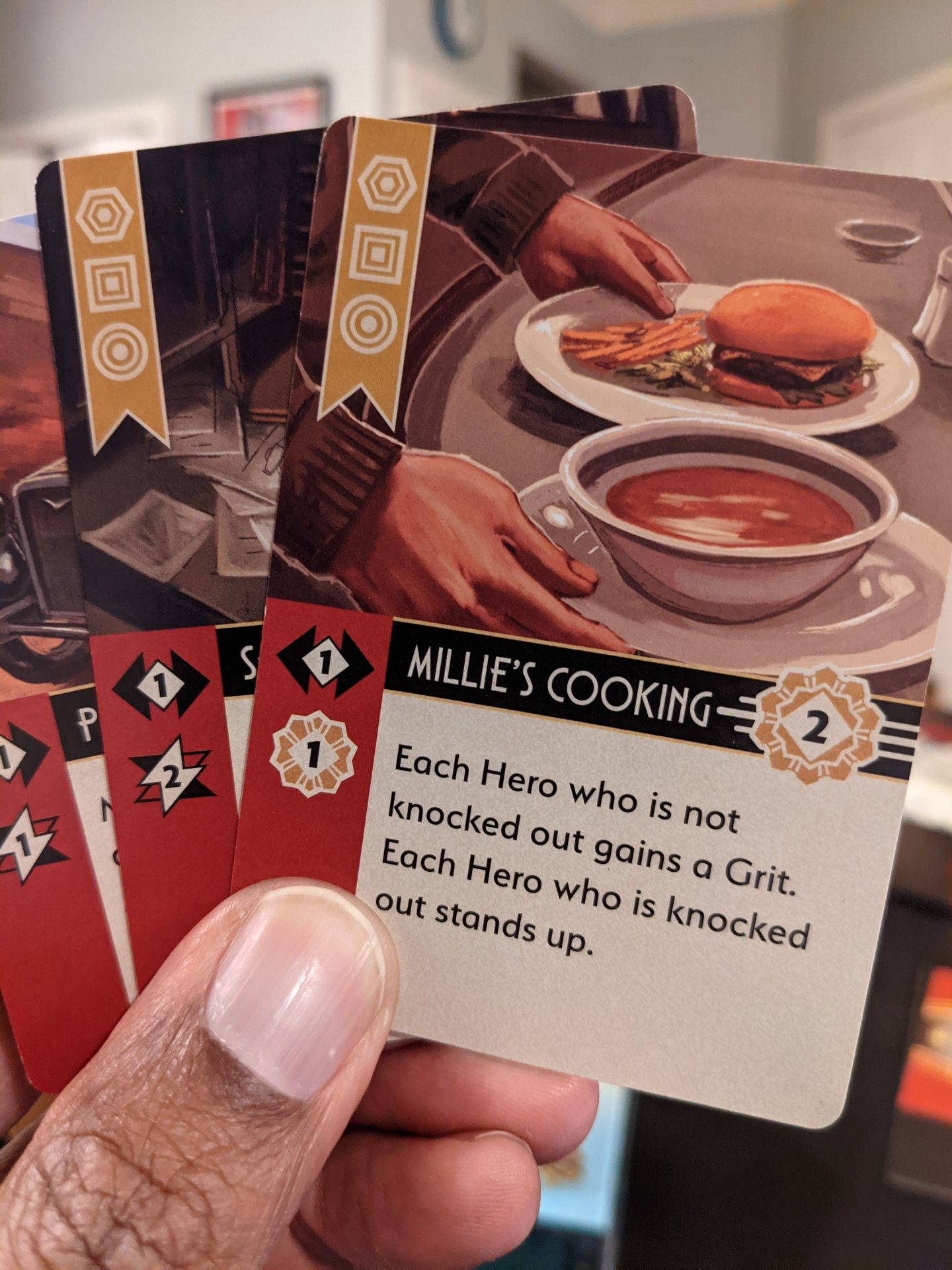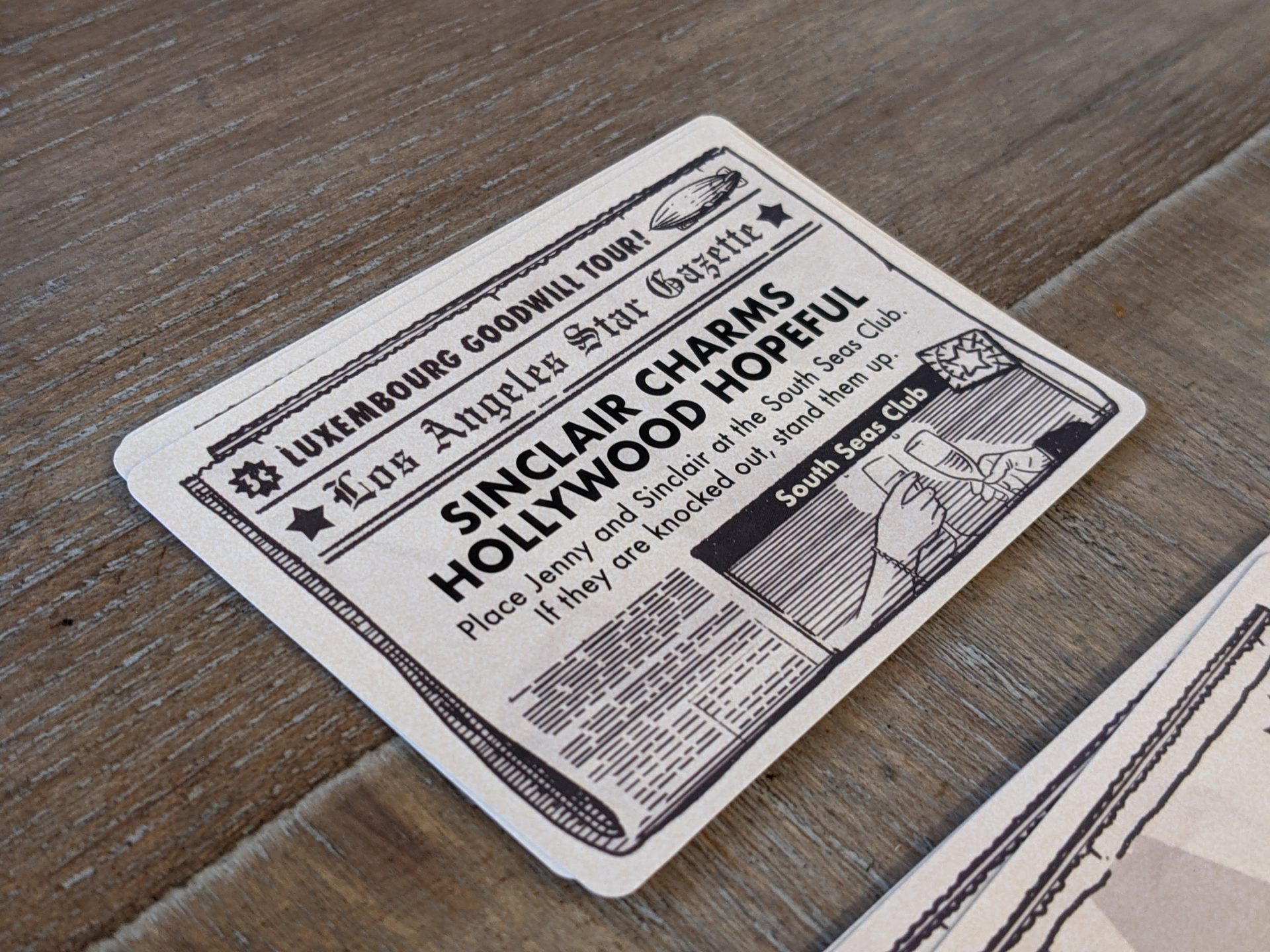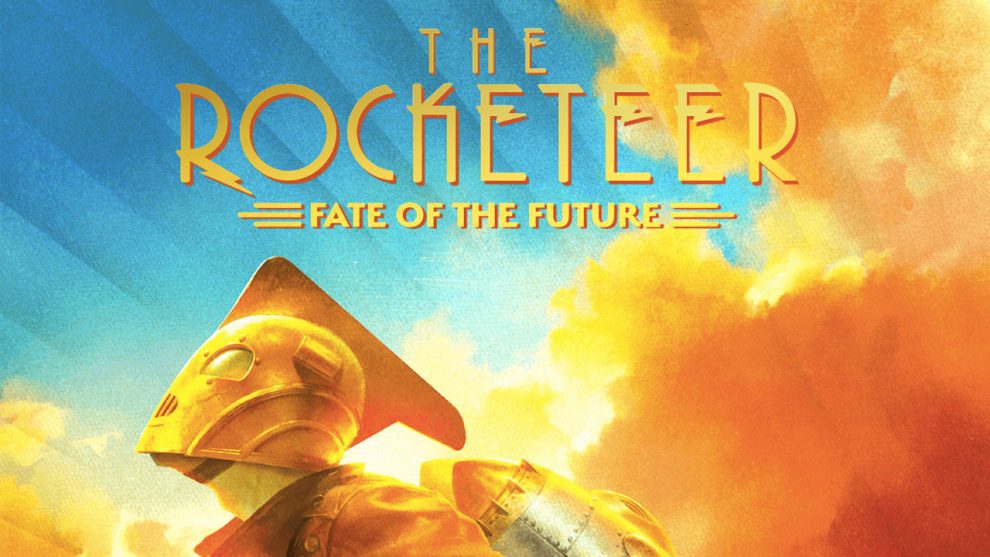“The Rocketeer? Who thought that was a good idea?”
Let’s talk straight: I still have no idea why anyone thought it would be a good idea to base a new board game on The Rocketeer, a 1991 Disney film that was a middling box office disappointment.
So, in preparation for this review, I went back and watched the Disney film, released in theaters 30 years ago.
In The Rocketeer, the setting is Los Angeles, 1938. Pilot Cliff Secord (Bill Campbell) is struggling with money; his girlfriend Jenny (Jennifer Connelly) is struggling to find work as a Hollywood extra. But their fortunes change when Cliff discovers a futuristic jetpack stashed in a hangar which just happens to be designed by Howard Hughes (Terry O’Quinn, way before the ABC show Lost made him a true household name) and desired by the mob, the Nazis, and the American government.
Over the next 100 minutes, Secord uses the jetpack to become The Rocketeer, while trying to keep the jetpack out of the hands of his pursuers. A famous actor—and Nazi spy—named Neville Sinclair (Timothy Dalton, in between Bond movies) tries to woo Jenny in an attempt to learn the whereabouts of the jetpack, in an attempt to help the Nazis win World War II through domination of the skies.
The movie is a riff on serials from the 1930s and 40s, and it never really makes a dent. The twist on the Sinclair character, and what we know now about Errol Flynn’s possible role as a spy during his real-life film career, gives The Rocketeer a slight edge for its final act as the Nazis show up with a “secret army” and a Zeppelin to steal the jetpack.
The film opened weakly at the box office in 1991; despite being planned as a trilogy (Campbell was contracted for three films), The Rocketeer ended up being a one-and-done that now has a cult following. But Funko Games and the Prospero Hall team decided to turn this intellectual property into a 2-player game called The Rocketeer: Fate of the Future.
And unlike the mediocre film, The Rocketeer: Fate of the Future is pretty good. The only thing that both the game and the movie fail at is knowing when to yell out “Cut!”

To Infinity…and Beyond!
The Rocketeer: Fate of the Future pits two players—and only two players—against each other to score the most points. One player is the Heroes: Cliff, Jenny, and Peevy (the ace mechanic who was played by Alan Arkin). The other player takes on the role of the Villains: Sinclair, Lothar (the oversized henchman who works for Sinclair), and Valentine, the head of the mob working with Sinclair to secure the jetpack.
Each player has their own deck of cards; over the course of 5-6 rounds they will manage a hand of 7 cards which offer abilities and actions for each character, based on symbols in the upper left-hand corner of each card. Through a mix of area control, Abilities on the cards which score points, and holding blueprints known as “The Plans” at the end of each round, players will earn Finale cards, most of which score 0-6 points each. Rounds are tracked by a Zeppelin standee, and when that standee moves all the way to Los Angeles, one last round is played and points are added up.
The rules for playing cards reminded me a bit of one of my favorite games, the underappreciated Martin Wallace game Wildlands. In that game, just like The Rocketeer: Fate of the Future, your cards can only be used by certain characters, and you can play as many of your 7 cards as you would like across your 3 characters.
Both factions play mostly the same, save for one main difference. The Villains’ Valentine character turns into “The Secret Army” the first time Sinclair or Lothar plays a Secret Army Ability. For the rest of the game, this allows for the bad guys to place Secret Army tokens at different locations on the board—all of which were featured in the movie, like the iconic Bull Dog Cafe, Chapel Airfield, and the Sinclair Mansion—to give the Villains a slight edge in spreading out across the board for end-of-round bonuses, with a disadvantage of fairly weak troops holding each area.
Also, both sides are constantly chasing the other for the Plans, which are three cards held by one faction to motivate fights (whoops, “Tussles”). The player who is currently in possession of the Plans will get a free Finale card at the end of each round. The Plans will change hands a couple of times each game, and it is not even important who is holding them at the end of the game; they are the second tiebreaker, should the game come down to that.
The other control element in The Rocketeer: Fate of the Future is tied to the six locations in the game. Whoever has the majority presence at a location at the end of a round gets a bonus, to aid in acquiring Finale cards in future rounds, with one of the six highlighted as a place that will earn one additional Finale card if held in that round. There’s also an event deck to change up a round’s rules, albeit slightly, and indicate if the round marker will move towards Los Angeles.

The Cards
I’ve enjoyed The Rocketeer: Fate of the Future so far, and that’s mainly because of the cards.
The combos available are fun. The iconography is clean. Even after a single play, you’ll begin to plan around what your deck has to offer each round; using certain cards to attack your opponent (or defend against Tussles, because cards used to defend can only be used if that card aligns with the character being attacked) and other cards to just move to other locations to ensure you have control at the end of the round…all of this is fun. The Rocketeer: Fate of the Future is a little heavier than I was expecting, as a strategy game and not a quick skirmish game or as a race to grab the most points in a short amount of time.
Stringing cards together and gathering the most Finale cards is your ultimate goal. And after losing my first game because of the game’s initial tiebreaker—holding the most Finale cards—I made a note to make sure I grab as many of those cards as possible in future games, to much success.
Cards are why I will keep playing The Rocketeer: Fate of the Future. The fights are not interesting, until you factor in the timing of when to try and knock out someone who is low on defensive measures, which makes them likely to reveal the Plans. For the most part, if you are holding the Plans, you will spend turns finding ways to beef up your character’s defense (known as Grit), gathering Clout (coins) to activate card abilities, and spreading out so that you can earn as many end-round bonuses as you can. But there are so many satisfying ways to make the cards align.

Patience!
The main glaring negative with The Rocketeer: Fate of the Future is the length of the game.
My sense is that The Rocketeer: Fate of the Future should either be quicker, or a little less strategic. The first turn of a round for each faction is a little slow, but gets quicker as the round goes along since you will only have a couple of cards left to play for your third character (the game allows for you to activate characters in any order). Planning out your actions is tricky, especially when you don’t know the deck that well.
But my first two games of The Rocketeer: Fate of the Future took a little more than an hour each. That’s too long for a game like this. Sometimes, you will draw an event card that does not advance the Zeppelin, but normally it moves. I like that you’re never really sure when the game will end, but the action is not interesting enough to prolong what is basically an area control game with blind draw scoring mechanics (Finale cards are wildly random, and also give bonuses if you happen to be holding certain locations at the end of the game).

Blast Off (Conditionally)
I have enjoyed The Rocketeer: Fate of the Future because it features interesting decisions, light interaction and a production that is pretty strong given its almost-unreal $25 MSRP. The hand management mechanic is why I keep coming back to it, and the game is relatively easy to teach to a newcomer.
I play 99% of my 2-player-only games with my wife, and she enjoyed this as well. It’s a little too long with the base rules, and I don’t believe this is a game that will be a lifer in my collection because once my wife and I get a good feel for both decks, it will take expansion content to enrich the experience. I also played the game once with another friend in my gaming group and he was very impressed by the decision space; the game fits nicely as a heavy game for those who don’t play a lot of similar experiences, and a light-to-midweight game for those who are deeply invested in the hobby.
A side note about the artwork for The Rocketeer: Fate of the Future: the characters are drawn in a way similar to their movie characters, but also they are very clearly drawn to NOT be Jennifer Connelly, or Timothy Dalton, etc. Was this the artwork from the original graphic novel in the early 80s, before the film rights were sold? Storyboard art before the movie was made? Or, maybe original sketches for the board game?
No matter what, The Rocketeer: Fate of the Future has a nice look that I’m into!












Add Comment